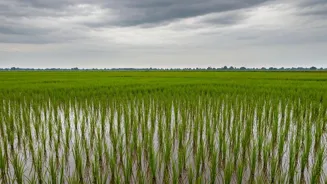Weather's Sudden Turn
The meteorological landscape of Punjab, Haryana, and Chandigarh witnessed a dramatic change with the arrival of heavy rainfall. This unseasonal downpour
has brought about an unexpected alteration in the usual weather patterns. The intensity and timing of the rain have been notable, creating disruption, especially for agricultural activities. The shift in weather, catching many by surprise, has left a significant impact on daily life and the local economy. The extent of the impact is still being assessed, but the immediate consequences have been felt across the region, particularly in areas reliant on agriculture.
Paddy Harvesting Affected
The most significant impact of the heavy rains has been on the paddy harvesting process. Paddy, being a major crop in the region, is in the crucial stage of harvesting when these weather events occurred. The rain has caused delays in the harvesting operations. Waterlogged fields have made it difficult for farmers to access their crops and complete the harvest efficiently. The quality of the harvested crop is also at risk. Excessive moisture can lead to spoilage and a decrease in market value. Furthermore, the delayed harvest could impact the overall yield, affecting both farmers and the regional agricultural economy. The situation is complex, requiring immediate attention from the authorities and agricultural stakeholders.
Challenges for Farmers
Farmers are facing numerous challenges due to the heavy rainfall. Firstly, the waterlogging of fields has made it nearly impossible to carry out the harvest with the usual machinery. Laborers are also struggling to work in these conditions, leading to further delays. The cost of post-harvest activities is also rising. The need for drying the crops before storage adds extra expenses for farmers. Moreover, the potential for crop damage adds to the financial burden. The situation demands urgent interventions to support farmers during this difficult period. Government agencies are likely to provide assistance through various schemes, along with advice on crop management strategies.
Economic Ramifications
The impact of the weather shift extends beyond individual farms to the regional economy. Delays in harvesting and potential crop losses could affect the supply chain. Reduced yields might lead to higher prices, affecting consumers. The agricultural sector's contribution to the gross domestic product (GDP) could also be affected. These economic effects require careful monitoring and prompt action. Policymakers and economic analysts are likely to evaluate the overall implications. Measures to stabilize market prices and ensure food security might be necessary. The long-term economic consequences will depend on the duration of the weather disruptions and the effectiveness of the response.
Looking Ahead
The agricultural sector is preparing for the challenges ahead. Authorities and agricultural departments are likely to provide guidance and support to farmers. Weather forecasts will be closely monitored to anticipate future changes. Measures might include providing assistance to farmers, assisting them in accessing better drying facilities and providing aid to minimize the losses. There is an urgent need for climate-resilient farming practices. These include alternative crop choices and water management strategies. The aim is to build the region's ability to withstand future weather uncertainties and protect the livelihoods of farmers and the overall economy.












